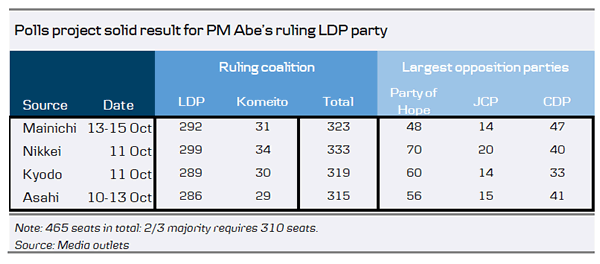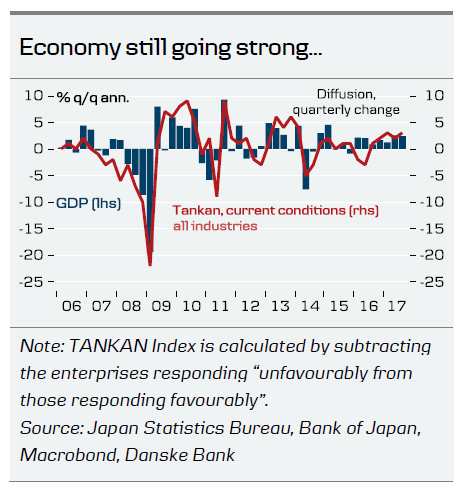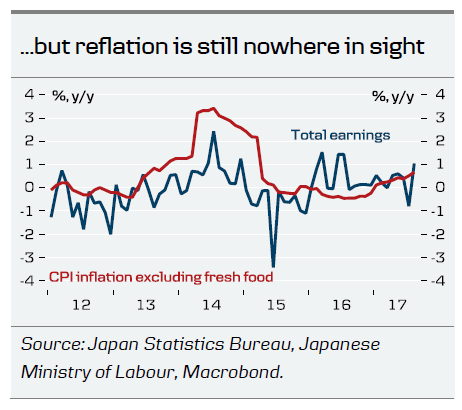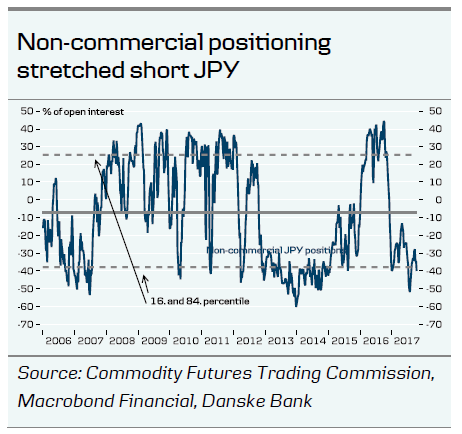Today’s key points
- PM Abe’s LDP close to maintaining single party majority in Lower House.
- Looks like vote of confidence in Abenomics and thus a reappointment of BoJ governor Kuroda and a continuation of QQE and YCC.
- USD/JPY could bounce higher if Abe wins, but relief rally should be shallow and short-lived
Shinzo Abe and his Liberal Democratic Party (LDP) are poised to remain the biggest party by far and continue in government after the general election to the Lower House on 22 October. In Japan, the electoral system tends to favour the biggest party. In the 465-seat Japanese Lower House, 289 seats are elected in single constituent first-past-the-post elections while the remaining seats are elected with proportional representation. The main question is currently whether the LDP and its coalition partner Komeito can maintain their two-thirds super majority that they have held since the general election in 2012. Abe needs to form a two-thirds majority in order to realise his plans to revise Japan’s 70-year-old pacifist constitution, and thus validate the existence of the Japan Self-Defense Force. For this, he probably needs to collaborate with the new Party of Hope and not the Buddhist pacifist Komeito.
For a while, PM Abe might have regretted his 25 September call for a snap election, as Tokyo governor Yoriko Koike founded Kibō no Tō (Party of Hope) just hours before Abe declared an early election. Koike is a popular political figure in Japan and a former minister of defence in the first Abe cabinet. When the leader of the opposition Democratic Party (DP), Seiji Maehara, announced that the party had split just a few days later, and many of the representatives started to emerge as candidates for Party of Hope, a united opposition and a strong alternative to LDP rule was suddenly a possibility. However, not all DP candidates got along with Koike, which has split the opposition once again as the new Constitutional Democratic Party of Japan (CDP) rose from the ashes. Furthermore, Koike has decided not to run for parliament, which effectively leaves Party of Hope without a PM-candidate.


Polls look promising for Abe
Abe has probably breathed a sigh of relief, as recent polls have ticked in suggesting that the LDP will win a significant majority. The newspaper Mainichi gives the LDP 292 seats in the 465-seat Lower House. Adding Komeito’s projected 31 seats gives the coalition close to 70% of the seats, slightly more than they held before the house was dissolved. Party of Hope and the CDP currently stand to win only 48 and 47 seats, respectively. If the polls remain unchanged, it would put Abe on track to be re-elected as chairman of the LDP in September 2018 and thus likely to become the longest-ever serving Japanese prime minister. With as many as 43% of voters preferring not to see Abe stay as prime minister and an approval rating of only 37%, this outcome could appear somewhat puzzling, though. Lack of any clear alternative is part of the explanation. That said, the majority of voters have still not decided who to vote for, which means there is still uncertainty over the election outcome
Economy still in great shape but sales tax hike is looming
Should Abe’s coalition stumble at the finish line, Japan is not likely to change political course dramatically. Party of Hope is a conservative party close to the LDP in many areas. One key difference relates to the planned sales tax hike in October 2019, though. Abe needs it to fund social security spending and at some point pay down Japan’s enormous debts. Koike wants to freeze it to ensure economic recovery and impose a tax on companies’ internal reserves instead. Also, the CDP does not want to impose the hike all at once.
We expect the Japanese economy to stay on track, supported by the global economic recovery. The large Japanese manufacturing sector recently showed the most optimistic business outlook in a decade and the economy in general seems in good shape. That said, it is a risk that Abe will focus too much on revising the constitution and refrain from working hard on the third pillar of Abenomics (structural reform). No matter what, it remains a challenge for Abe to keep the economic upturn going for another two years so Japan does not go into recession when the sales tax hike hits. It might be wiser to make the increase gradually in order to avoid a situation like 2014, where private consumption surged due to exactly a sales tax hike. We saw some improvement in domestic demand earlier this year, but generally the economy is still very dependent on the global economic recovery and an ultraaccommodative economic policy still looks necessary.
In our main scenario, we expect the Bank of Japan (BoJ) to keeps its policy unchanged, maintaining the short-term policy interest rate at -0.1% and the 10Y Japanese government bond (JGB) yield at 0% over our 12M forecast horizon, assuming BoJ governor Haruhiko Koruda is reappointed when his term ends in April – this seems likely, as Abe can do this with a simple majority.
FX outlook: we still look for a higher USD/JPY
Solid victory for Shinzo Abe expected in the FX market……. Financial markets seem complacent that Abe will remain prime minister after the general election on Sunday, and there is hardly any election risk premium priced in the FX option market. Hence, while USD/JPY could bounce higher after the election if Abe secures a two-thirds majority, market pricing indicates that a possible relief rally would be shallow and short-lived.
But… USD/JPY supported by Fed-BoJ divergence and global business cycle We still see USD/JPY moving higher in coming months as the global business cycle environment remains constructive for the cross and as we expect the Fed will hike interest rates in December. We target the cross at 113 in 1M (previously 111) and 114 in 3M. Longer term, we expect the combination of 1) Fed-BoJ divergence, 2) higher global yields (eventually) supported by global growth recovery and 3) portfolio outflows out of Japan will continue to keep the cross floating. We target USD/JPY at 115 in 6M and 116 in 12M. Downside risks to our forecast primarily arise from the yen’s high correlation with 10Y US yields, a high sensitivity to risk appetite in general and a stretched short JPY positioning.

















